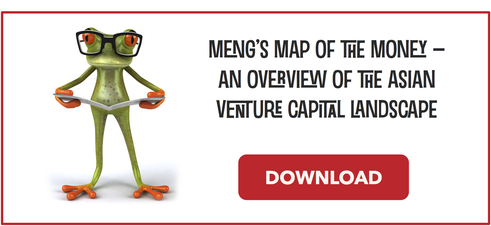Is VC funding right for me? Can my startup get funded in Singapore? Will I have to give up control?
August Man magazine interviewed Meng recently. In this excerpt, he answers those questions and more.
Bonus download: “Meng’s Map of the Money”.

August Man: How has your personal experience in start-ups and raising funds shaped you as a VC?
They say you learn more from your mistakes than from your successes. I’ve certainly made plenty of mistakes. But that’s a good thing: Hugh Mason, my co-founder, and I are “operator VCs”. We believe that the best coaches are those who used to play the game. My first startup was bootstrapped, with only friends-and-family money. My second raised venture funding from a Silicon Valley VC. They were very different experiences. In the first case, we just did it; in the second case, we spent more than a year bouncing from one end of Sand Hill Road to the other. I learned that there are pros and cons to venture funding, just as there are pros and cons to going public.
I came away convinced that it was harder than it should have been. I wanted to make it easier for the next generation. I’m a software guy, so my first instinct is to treat tech entrepreneurship itself as a technology challenge: could one build a business to systematise innovation? To make startups less risky – and entrepreneurship less lonely? It turns out the answer is yes: in Silicon Valley, Paul Graham is motivated by the same ideas, and that has led to enormous success with Y Combinator, the first seed accelerator.
Paul is a technologist. He has firsthand experience solving hard problems from first principles, writing software for millions of users, building multi-sided platform markets, and creating new media communities (like Hacker News). He does content marketing, he knows how to build scalable systems, he knows how to do community management. And, unlike many naturals, he can teach it. He teaches it every day at Y Combinator. We teach it at JFDI.
A lot of people visit JFDI wanting to set up their own accelerator. But how will they add any value to startups if they haven’t done a startup themselves and can’t teach these things?
So, I in 2009, I turned to Hugh and said, “you and I are uniquely qualified to do this. Let’s see if seed acceleration will work in Singapore.”
August Man: Is VC funding beneficial for every company? Why or why not?
Venture funding is appropriate for high-tech, high-growth startups. But not every new business is a startup. Not every small business owner is an entrepreneur. Like the words “love” and “dating”, “innovation” and “startup” have many meanings – maybe too many!
In the venture industry, the technical definition of “startup” is surprisingly narrow. The new rojak stall that just opened in your hawker centre is not a startup. A two-man web and mobile development house is not a startup. They may be SMEs, but a startup that only ever becomes an SME would, in our eyes, be a failure.
A startup is destined to grow fast, and become huge, because it’s riding some innovative trend that is changing the world. A startup can be expected to cost a lot of money to build, maybe because it’s a multi-sided platform, maybe because it needs a few million users to start making money. A startup is a temporary organization in search of a sustainable and scalable business model (says Steve Blank). Once it finds that business model, it stops being a startup and starts being a real company. Facebook and Google are not startups, not any more.
I treat market demand as an independent variable. When it’s steamboat time, you steam. If you don’t, someone else will!
So, for high-tech, high growth startups, it’s rarely one person having a go – it’s a lot of people trying, but only one succeeding. VC funding is often a necessary part of this equation, because if you don’t have VC funding, your competitors surely do. They will outspend you, and nine times out of ten, you will fail. One time out of ten, the market will be slower to take off than everyone expected: they will outspend you, and they will fail. So there is some room for individual variation.
August Man: What sort of ideas intrigue you personally?
I am inspired by two Arthurs.
Arthur C. Clarke said, “any sufficiently advanced technology is indistinguishable from magic”.
And Arthur O’Shaughnessy (almost) said, “We are the magic makers, // And we are the dreamers of dreams”.
We want our startups to make magic. We want to see science fiction turn into business fact. Our favourite ideas are those which trigger a sense of wonder.
This directly informs our investing. The litmus test is simple: if this startup succeeds in changing the world, is that new world a future where I want to live?
August Man: Why did you choose to invest in companies like RedMart?
Redmart was a personal angel investment, not through JFDI. I met the team while they were still MBA students at INSEAD. I liked them and I liked their idea. They tell me that my early support helped encourage them to pursue the vision at a time when many others doubted.
Rationally, the economics of ecommerce favour storeless groceries. In the UK, Tesco proved that customers would rather order bulky, heavy groceries online and get them delivered. We’re all used to the alternative: scrounge for a $1 coin to release a shopping cart, wheel it around hunting for toilet paper and laundry detergent, spend half an hour queueing to pay, fail to get your $1 back, and earn red marks on your fingers lugging it all home. But it actually costs more to run a retail store than to deliver the groceries out of a warehouse. With delivery, everybody wins, except the Goliaths – Cold Storage, NTUC Fairprice, Sheng Siong. They can’t compete with the storeless model, yet their ideology keeps them from disrupting themselves.
So Redmart made sense as an investment.
Emotionally, selfishly, I just wanted to live in a world where my fingers wouldn’t hurt from carrying plastic bags home.
Besides, there’s a bigger theme: we are going back to traditional ways of living. When I was growing up, groceries came in a van visit twice a week. I think it’s cool that we’re moving back to that.
August Man: What is the current landscape in Singapore for new companies seeking capital?
There is more money in Singapore than there are good startups to invest in. For scale, consider this: the entire US venture capital industry has about $200 billion in assets under management (AUM). In Singapore, Temasek and GIC, together, have a bigger AUM. And the government is vigorously stimulating the sector with grants and co-investment schemes: from iJam to TECS to TIS and ESVF, there’s money available to any Singaporean who has what it takes.
If you’re not a Singaporean citizen or PR, public money is understandably less accessible. But there are dozens of private venture funds which don’t use any government money. They can invest in anyone. That’s important, because research shows that about 50% of entrepreneurs tend to be immigrants!
Those funds don’t just look in Singapore. They look for businesses operating in Indonesia, India, Vietnam, and every other country in Southeast Asia. The startups are often incorporated in Singapore, and that’s where the meetings happen and where the cheques are signed, but capital knows no borders.
We see a lot of American and European startups who are attracted by the money, but have no authentic reason to be in Asia. They don’t know how to reach Asian markets and don’t have any competitive advantage. It can be hard for them if they aren’t doing a truly global play, like a Skype or a Viki.
Read more about what the Viki Acquisition Means for Singapore.
I put together a Map of the Money which gives an overview of the venture capital landscape here. The PDF is available as a free download. (If you’re a VC listed on the map, stop by JFDI anytime to pick up a complimentary wall-size copy.) Entrepreneurs should see also Florian’s MAVA.
August Man: How much control do you expect to exert after you’ve invested in a company?
JFDI’s 100-day accelerator program is intense. We don’t call it a bootcamp for nothing. Founders do very little but work on their startups. During that time, our bench of resident and visiting mentors spend, on average, one hour a day with the teams, on everything from core innovation, technology architecture, and first customer sale, to term sheet fundamentals and pitch practice. We’ve helped our startups file patents, deal with nuisance lawsuits, hire experienced managers, and choose which VC to take money from. Our breadth of experience, and our rigorous de-risking processes, are the reason 60% of our startups go on to get funded at the $500,000 level or more.
After Demo Day, we continue to support them, all the way up to Series A, but in a more reactive, opportunistic mode. Generally, we don’t sit on the board of directors. We’re a shareholder, on par with the founders. So we’re aligned to see them succeed, but we believe that after we’ve gotten them off to a good start, they should be able to walk and run on their own. So far, we’ve been proven right.
As an angel, I have very little time to advise the companies formally. I don’t attend any meetings and maybe I share a link once every couple of months. I set up JFDI so I could scale myself, so use that door!
This interview was adapted for publication by August Man magazine 2014. Meng is still not sure why they wanted to talk to him.


